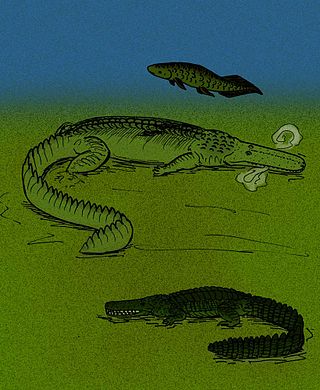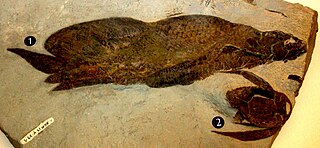| Eoctenodus | |
|---|---|
| Scientific classification | |
| Kingdom: | |
| Phylum: | |
| Class: | |
| Genus: | Eoctenodus |
Eoctenodus is an extinct genus of prehistoric sarcopterygian or lobe-finned fish. [1] [2]
Dipnorhynchus is an extinct genus of lungfish from the middle Devonian period of Australia and Europe.
Gosfordia is an extinct genus of prehistoric lungfish known from the Triassic of Australia.
Gogodipterus is an extinct genus of prehistoric lungfish in the family Chirodipteridae. It was discovered ar the Late Devonian Gogo Formation of Western Australia.
Cryptolepis is an extinct genus of prehistoric sarcopterygian or lobe-finned fish.
Holodipterus is an extinct genus of prehistoric sarcopterygian or lobe-finned fish.
Hainbergia is an extinct genus of prehistoric sarcopterygian or lobe-finned fish.
Oervigia is an extinct genus of lungfish in the family Rhinodipteridae from the Devonian of Greenland.
Namatozodia is an extinct genus of prehistoric lungfish. The genus, and its sole species, Namatozodia pitikanta, are described in Kemp (1993). The only known example of the species and genus is a small skull found in the Arcadia Formation of the Crater, in Western Queensland, Australia. This is an early Triassic formation.
Muranjilepis is an extinct genus of prehistoric sarcopterygians or lobe-finned fish.
Monongahela is an extinct genus of prehistoric sarcopterygians or lobe-finned fish. There are currently no confirmed surviving specimens.
Mioceratodus is an extinct genus of lungfish in the family Neoceratodontidae, which also contains the extant Queensland lungfish. It is known only from Oligocene and Miocene-aged sediments in Australia, although phylogenetic evidence supports it having first diverged from its closest relative, Neoceratodus, during the Late Jurassic or Early Cretaceous period.
Metaceratodus is an extinct genus of prehistoric lungfish in the family Ceratodontidae, with an indeterminate specimen known from the Late Triassic (Norian)-aged Lissauer Breccia of Poland and more complete specimens known from the Late Cretaceous of Queensland, Australia and Argentina. The genus was named and described by Frederick Chapman in 1914.
Sagenodus is an extinct genus of prehistoric lungfish. It is a lungfish from the Permo-Carboniferous period found in Europe and North America.
Rhinodipterus is an extinct genus of prehistoric dipnoan sarcopterygians or lobe-finned fish, that lived in the Devonian Period, between 416 and 359 million years ago. It is believed to have inhabited shallow, salt-water reefs, and is one of the earliest known examples of marine lungfish. Research based on an exceptionally well-preserved specimen from the Gogo Formation of Australia has shown that Rhinodipterus has cranial ribs attached to its braincase and was probably adapted for air-breathing to some degree as living lungfish are. This could be the only case known for a marine lungfish with air-breathing adaptations.

Retodus is an extinct genus of prehistoric lungfish found in Cretaceous-aged freshwater strata of Egypt, Algeria and Niger. The type species, R. tuberculatus, was named in 2006. It was originally named as a species of Ceratodus and Neoceratodus in 1963.
Pillararhynchus is an extinct genus of prehistoric sarcopterygians or lobe-finned fish.
Phaneropleuron is an extinct genus of prehistoric sarcopterygians or lobe-finned fish.

Paraceratodus is an extinct genus of prehistoric lungfish. Only one species, P. germaini, is known from the latest Permian or earliest Triassic period of Madagascar. Phylogenetic evidence supports it being the most basal member of the suborder Ceratodontoidei, which contains modern lungfish, and as with the rest of the order it likely diverged during the late Carboniferous.
Tranodis is an extinct genus of prehistoric sarcopterygians or lobe-finned fish. It was a lungfish from the Upper Mississippian of North America.

Scaumenacia is an extinct genus of prehistoric lungfish. It lived around the Devonian in North America alongside another prehistoric lungfish: Fleurantia. It lived from approximately 384 to 376 millions of years ago.